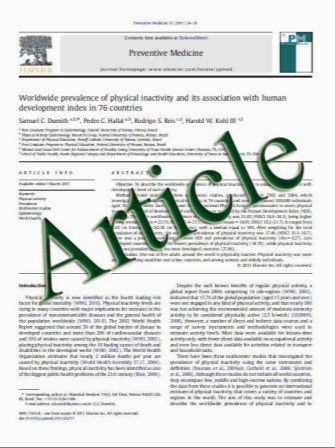Estimation of energy expenditure using accelerometers and activity-based energy models—validation of a new device
- نوع فایل : کتاب
- زبان : انگلیسی
- مؤلف : Sascha Hنrtel & Jens-Peter Gnam & Simone Lِffler & Klaus Bِs
- چاپ و سال / کشور: 2010
Description
Over the last few years, the estimation of energy expenditure with accelerometers has become more and more accurate due to improvements in sensor technology. Significant enhancement could be reached by model-based estimation regarding different activity types. The kmsMove-sensor (movisens GmbH, Karlsruhe, Germany) is a device that is used to compute human energy expenditure using motiondependent calculation models. It is outfitted with an accelerometer to measure body acceleration during certain movements and activities. To validate its accuracy, the sensor was compared to indirect calorimetry as criterion measure. For this experiment, nine subjects (all males, age 46.4±10.9 years, 28– 64 years) were equipped with the kmsMove-sensor as well as a portable indirect calorimeter and their energy consumption was measured over a time period of 100 min. Additionally, the energy consumption of seven out of the above-mentioned nine subjects was measured over an average of 7 h. The measurements took place in a rehabilitation clinic, where the subjects completed their regular daily rehabilitation activities. An analysis of the data revealed ICCs between the kmsMovesensor and indirect calorimetry for the time period of 100 min of 0.82 (0.38–0.96; p=0.003) and for an averaged measuring time of 7 h of 0.81 (0.22–0.97; p=0.01). Furthermore, a Bland–Altman analysis for the time period of 100 min led to a difference of the means of 4.3 kcal (limits of agreement: -94.3 and 102.9 kcal) and for the time period of an average of 7 h to -14.0 kcal (limits of agreement: -320.0 and 292.0 kcal). These findings indicate that the kmsMovesensor is an appropriate measuring device with relatively good accuracy to assess human energy expenditure in rehabilitation patients. However, this study has some limiting aspects (small sample size, artificial setting) which could influence validity.
Eur Rev Aging Phys Act DOI 10.1007/s11556-010-0074-5 Received: 9 July 2010 / Accepted: 22 November 2010


